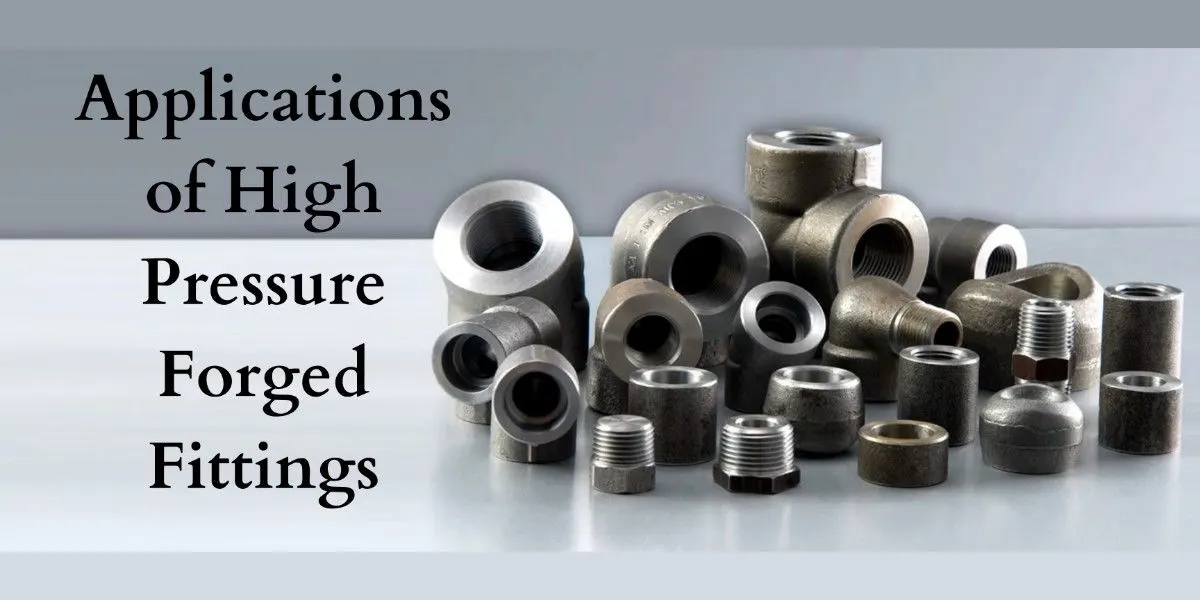Applications of High Pressure Forged Fittings
by Muskan Ahuja
Posted on September 23, 2021 at 5:00 PM

What are High Pressure Forged Fittings?
High Pressure Forged fittings are used to connect pipes connecting valves, pipes, pumps, & other equipment to create piping systems. High Pressure Forged Fittings are a type of pipe fittings typically used in oil and gas pipelines. The high-pressure forged fittings have a greater resistance to corrosion and abrasion than other types of fittings. High Pressure Forged Fittings are a strong, durable kind of fitting with a lower installation cost than others... High Pressure Forged Fittings (HPF) are a type of pressure-tempered fittings that can be used for different applications. HPF fittings use high pressure and heat to create a carcass with better structural properties and minimal distortion or deformation during installation.
Applications of High Pressure Forged Fittings
Forged Fittings are used in applications that require high levels of performance like ships and airplanes. The complex shapes make it difficult to manufacture these parts using conventional methods. High-Pressure Forging is the process of placing high pressure (frequently many thousand pounds per square inch) on a metal part, which forms the shape of the part, removing any excess material. High Pressure Forged Fittings have been tested to perform under extreme pressures. They are used in many industries, such as aerospace, nuclear power generation, and automotive. High pressure forged fittings are used for their high strength-to-weight ratio and the decrease of the amount of metal required. High pressure forged fittings are designed for use in high pressure, high temperature, corrosive fluids. This type of fitting is more commonly found in the production of natural gas pipelines. High pressure forged fittings have an increased fatigue life and can withstand the normally corrosive fluid conditions of natural gas pipelines. Many applications can use high-pressure forged fittings. For example, if you are building a water tower and need to quickly and effectively connect the tank to the piping, then forged fittings would be ideal. Another use for this type of fittings is when the manufacturer needs to create a more durable and reliable pipe than is available in the market.
Benefits of High Pressure Forged Fittings
High pressure forged fittings are the most suitable for steel production, primarily because they allow optimized functionality and performance. They can accommodate a wide range of applications in different industries. The benefits of forged fittings include corrosion resistance, which is important when transferring fluids, strength to withstand higher pressures or temperatures, and long-term durability. High Pressure Forged fittings use a high-pressure forging process in many applications. They are manufactured with great skill and precision by the strictest quality control methods to ensure that they provide all the required performance in an application. High Pressure Forged Fittings, like screw and bolt machining, is achieved at a pressure (up to 20 tons) and heat (up to 3,000 degrees Fahrenheit) that breaks the metal down into an extremely fine grain. This high-pressure process results in a stronger metal with improved corrosion resistance. High pressure forged fittings are high-performance, well-made components that can be used in a wide range of applications. They offer several key advantages over other types of fittings, such as longer service life and better corrosion resistance.
Other Uses of High Pressure Forged Fittings
High Pressure Forged Fittings are often used in areas where high pressure is applied. These areas can be found in petroleum and chemical industries, nuclear waste processing, and many other industries. They are also used in general engineering such as bridges, vessels, and pipelines. High-pressure forging is a method of manufacturing round tubes and flat parts by using high pressure and temperature. It is the process of deforming a piece of metal into a certain shape by heating it to high temperatures. High-pressure forging can be used in many different fields such as aerospace, automotive, construction, marine, and power transmission A typical high-pressure forged fitting is used to withstand high pressure, such as 200 atmospheres or greater. It uses a process called forging--where metal is heated and squeezed under pressure to produce a type of metal with a harder surface area and increased strength.
Tips for Working With High Pressure Forged Fittings
There are a variety of applications where high-pressure forged fittings may be used. To start with, these types of fittings are suitable for industry-leading materials such as carbon steel, stainless steel, and aluminum. In addition, these high-pressure fittings also work well when used with other metals that have a hardness of less than 60 HRC. The key to successfully working with this type of fitting is to use an appropriate lubricant in order to prevent any adhesion or corrosion issues. Being an experienced mechanic, I know that even among the most skilled mechanics, the use of High Pressure Forged Threaded Pipe Fittings can sometimes be problematic. Here are some tips for working with them to ease this. If you are not experienced with these types of fittings, using these tips will greatly increase your chances of getting the job done optimally.
Conclusion
We've seen that there are numerous benefits to using high-pressure forged fittings. These include the lower cost, less lead time, and the ability to customize the design to suit your needs. There is a growing demand for high-pressure forged fittings because of their ease of installation and their ability to withstand highly corrosive environments. Amardeep Steel takes pride in offering the best quality of High Pressure Forged fittings to its customers. A new generation of HPDs has more corrosion resistance, a longer life span, more efficient shut-off at a lower temperature, and greater design flexibility.